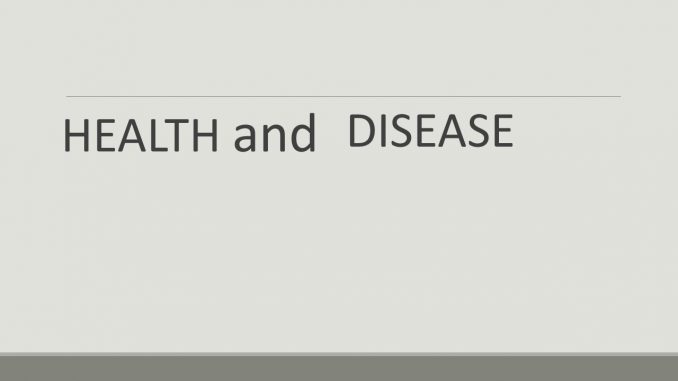
Health and Disease: Concept of health and classification of disease
- Health- “Health is defined as a state of complete physical, mental and social well-being and not merely the absence of disease or infirmity”. (WHO)
- Disease- (dis+ease): Disease is just opposite of health ie. Any deviation from normal functioning or state of complete physical and mental well-being.
Concept of health
There are four major concepts of health
1. Biomedical concept- This concept is based on the germ theory of disease, proposed by Robert Koch.
The postulates of germ theory of disease states that-
- Microorganisms are responsible for the disease.
- These microorganisms can be isolated from the diseased host and can be purely cultured in laboratory
- The isolated organisms in pure culture when injected to healthy susceptible host can produce same disease
- The microorganisms can be isolated from experimental host, both in smear and culture.
2. Ecological concept- This concept states about equilibrium between host (Human), infectious agents and the environment they share. So, health is dynamic equilibrium between human and their environment.
3. Psychosocial concept- This concept states about social cultural and economic as well as psychological factors in defining health and disease.
4. Holistic concept- This concept includes all biomedical, ecological and psychosocial concept in defining health and disease.
Classification of disease
Diseases can be classified into following 6 groups
- Diseases of biological origin: Diseases causing organisms such as bacteria, viruses, parasites, protozoans and worms are etiological factor. Disease caused by such organisms are commonly known as infectious diseases or communicable diseases. For examples, cholera caused by Vibrio cholerae.
- Social diseases: these diseases are commonly known as human induced diseases because the diseases are introduced by the activities of either individual or the society. Social life style as well as the modern industrialised societies are particularly associated with diseases such as alcoholism, drug abuse, coronary heart disease, lung cancer, accidents, pollution related respiratory diseases etc.
- Deficiency disease: diseases caused due to absence of certain nutrients in diet. Absence of protein in diet causes kwashiorkor and marasmus. Similarly absence of vit. B1, vit.C and vit.D causes pellagra, scurvy and rickettsia respectively. Other examples of such deficiency diseases are goiter,
- Genetic and congenital diseases: the diseases that are present before birth is known as congenital diseases. Most of the genetic disorder or diseases are congenital. Examples. Down’s syndrome, cystic fibrosis, colour blindness, hemophilia etc
- Degenerative diseases and ageing: degeneration of body tissue can also causes diseases. As people aged, many tissue degenerate and lost their function partly or completely, resulting in disorder, for eg. Long sightedness in old is due to weakening of eye muscles. Other examples are- arteriosclerosis, arthritis etc
- Mental disorder: it includes large group of diseases from anxiety and depression to schizophrenia and madness.
Broadly all the diseases are classified into TWO major groups
1. Infectious or communicable diseases:
- These diseases are caused by pathogenic organisms and are transmitted from one organisms to another directly or indirectly. So these diseases are also known as communicable or transmissible diseases. Pathogenic microorganisms may be transmitted by food, water, aerosols (droplet) or bite of certain arthropods or other animals. They may also be transmitted by direct contact or by sharing contaminated objects with infected person. On the basis of mode of transmission, infectious diseases are sub grouped into following
- Water borne disease: cholera, typhoid
- Food borne disease: food poisoning,
- Air borne disease: influenza, TB,
- Diseases transmitted by direct contact: AIDS, hepatitis
- Arthropod borne disease: malaria, kala-azar
- Zoonotic disease: rabies
2. Non Infectious or Non communicable disease:
- Social diseases, deficiency diseases, degenerative diseases, genetic or congenital diseases and mental diseases are non-transmissible as no infectious agents are involved rather various factors are responsible for occurance of diseases. For any non- communicable diseases, a number of factors are responsible known as web of diseases.
